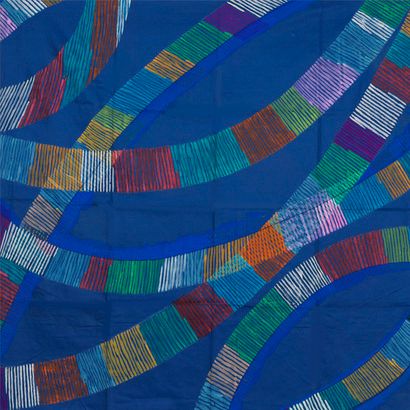Piero Dorazio
In 1947, Dorazio obtained a scholarship to study at the École des Beaux-Arts in Paris, where he spent a year and met Severini, Braque, Vantongerloo, Pevsner, Arp, Sonia Delaunay, Le Corbusier and other important artists.
After the Second World War, he participated in the foundation of a group of artists under the name of Forma 1, active from 1947 to 1951.
We join here the approach of these post-war artists, as I spoke to you recently in the context of the exhibition "At the heart of abstraction, from the collection of the Gandur Foundation for Art" which was held at the Maeght Foundation in Saint Paul de Vence.
The Forma 1 group wanted to reconcile the irreconcilable, namely abstraction and the figurative, by publishing the Forma 1 Manifesto.
This impulse of freedom of the artists calls for a progressive, revolutionary and avant-garde society.
This group was composed, besides Piero Dorazio, of artists such as Ugo Attardi, Piero Consagra, or Carla Accardi founder in the 70s of the "Revolta Femminile", the first exclusively feminist group founded in Rome.
In 1950 he participated in the organization of the cooperative gallery of the Golden Age group in Rome and Florence and in 1952 he promoted the international foundation Origine in Rome, which published the periodical Arti Visive.
In 1953 he went to the United States, where he met Motherwell, Rothko, Kiesler, Kline and Clement Greenberg, Jackson Pollock, Willem de Kooning, Mark Rothko, Barnett Newman, Robert Motherwell and held his first solo exhibitions in New York.
Under the influence of these artists, he began to experiment with a new style influenced by abstract expressionism. The Soma paintings he made were similar to Pollock's automatism.
After his return to Rome in 1954, Dorazio traveled between Paris, London and Berlin, where he became friends with Will Grohmann and the dealer Rudolf Springer.
It was then that he advanced his abstract style with an emphasis on hard-edge painting.
He traveled to Switzerland, Spain and Antibes in 1957, the year of his first solo exhibition in Rome.
In 1961, in Berlin, Dorazio participated in the activities of the Zero Group led by Heint Mack and Otto Piene.
It was there that he moved towards simpler compositions and began to use the cross-hatched diagonal, which is now most often associated with his style.
Abstract expressionism was a major inspiration for him, as was Futurimse, where Dorazio really began his life as an artist. Let us remember that Futurism is an Italian interpretation of Cubism, without wanting to simplify or denigrate this major movement.
We find in Dorazio's painting this capture of movement or speed as in Futurism
Dorazio established a masterful balance between harmony and movement.
He went on to hold various teaching positions in both Europe and the United States while combining his travels in Greece, Africa and the Middle East.
Piero Dorazio has been an artist always in search.
Among the many exhibitions of his work held in Italy and abroad are those at the Museum of Art
Elodie Couturier, expertisez.com
Youtube expertisez


